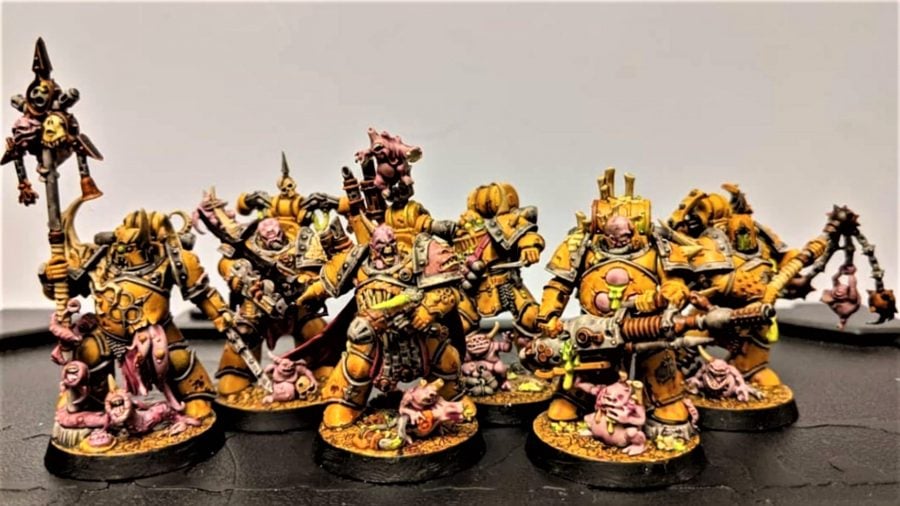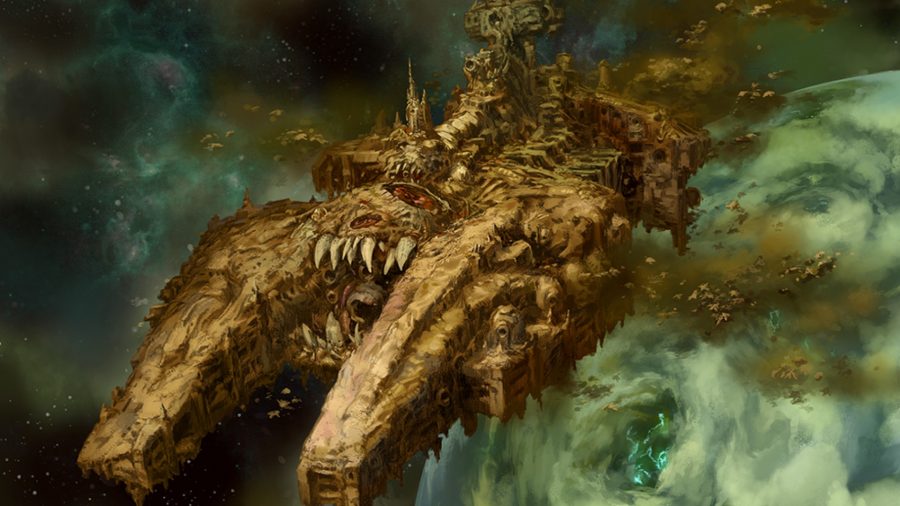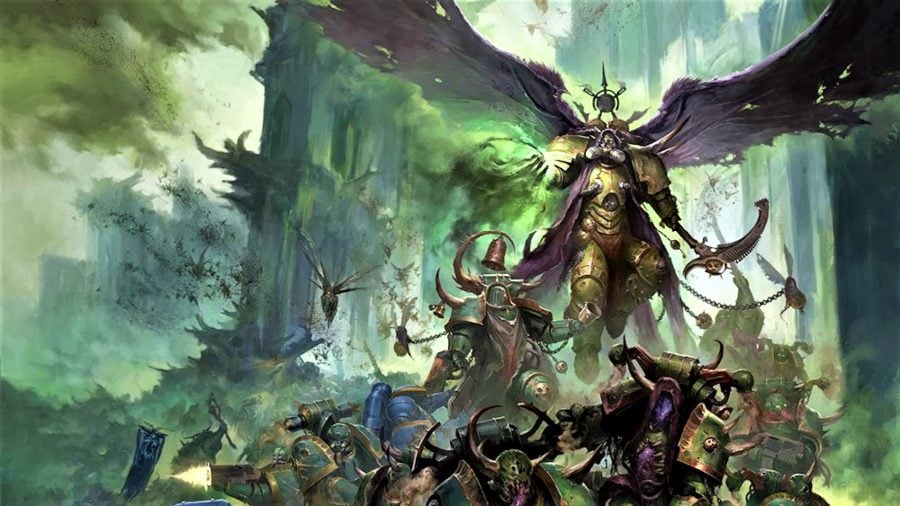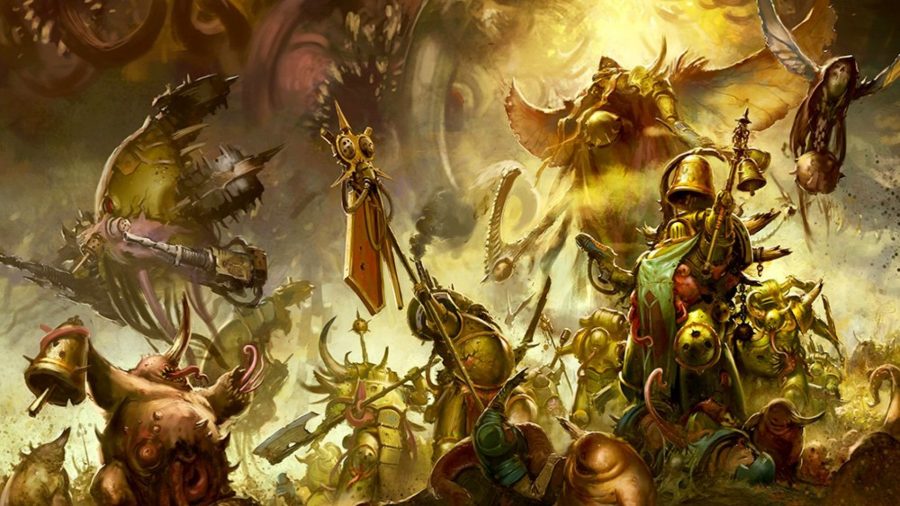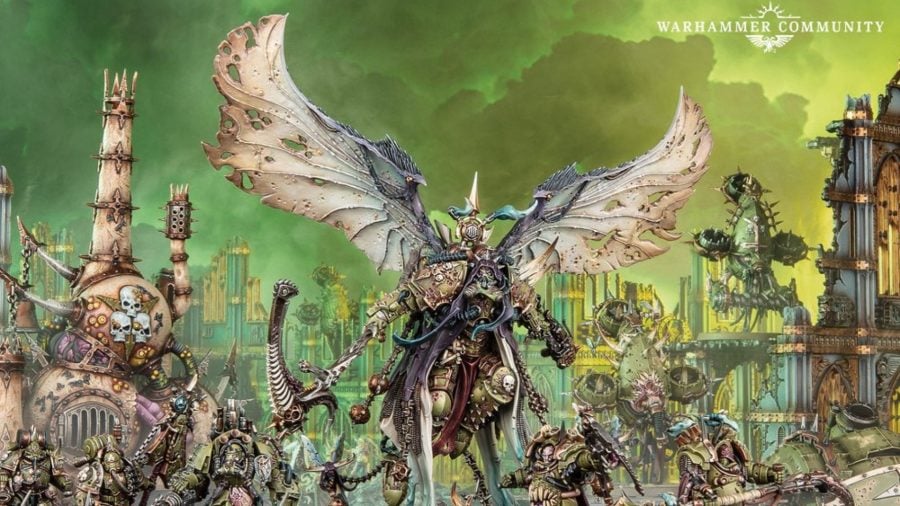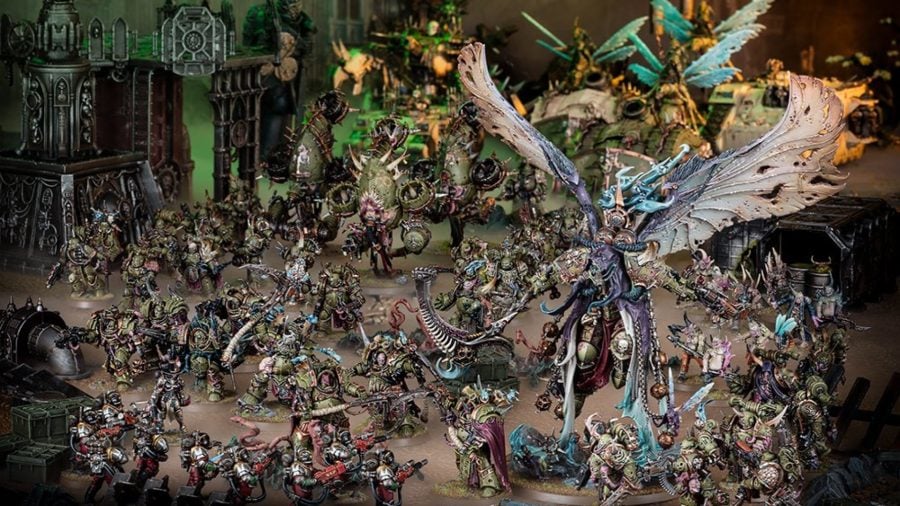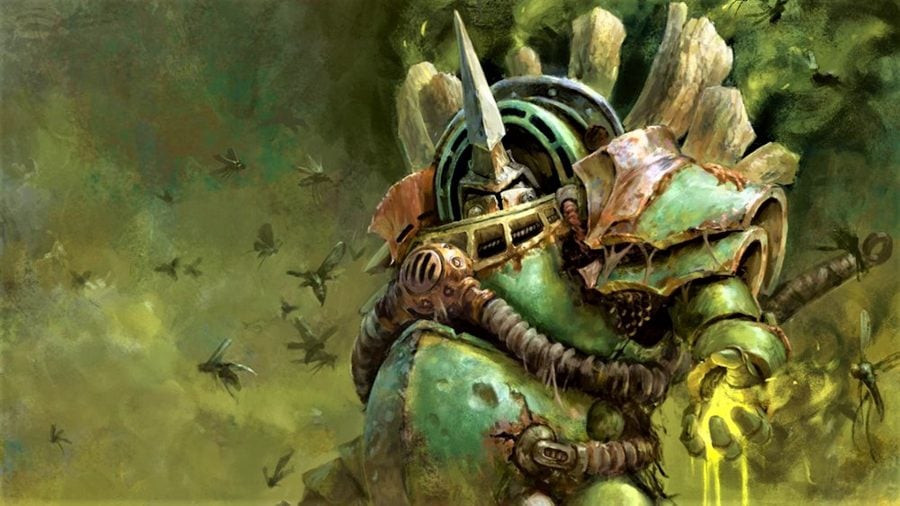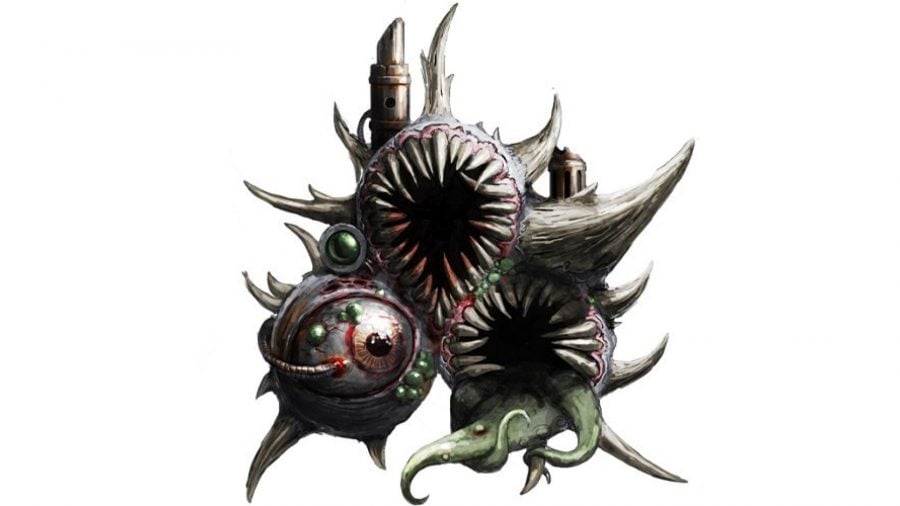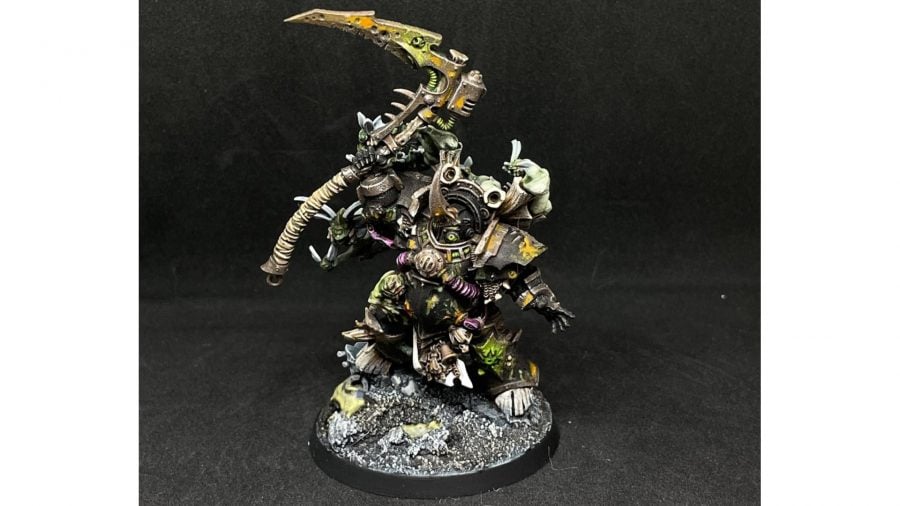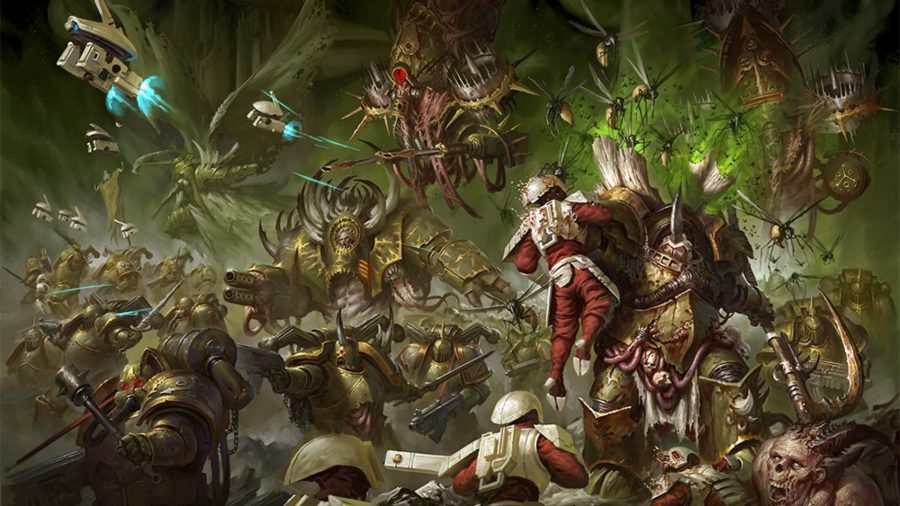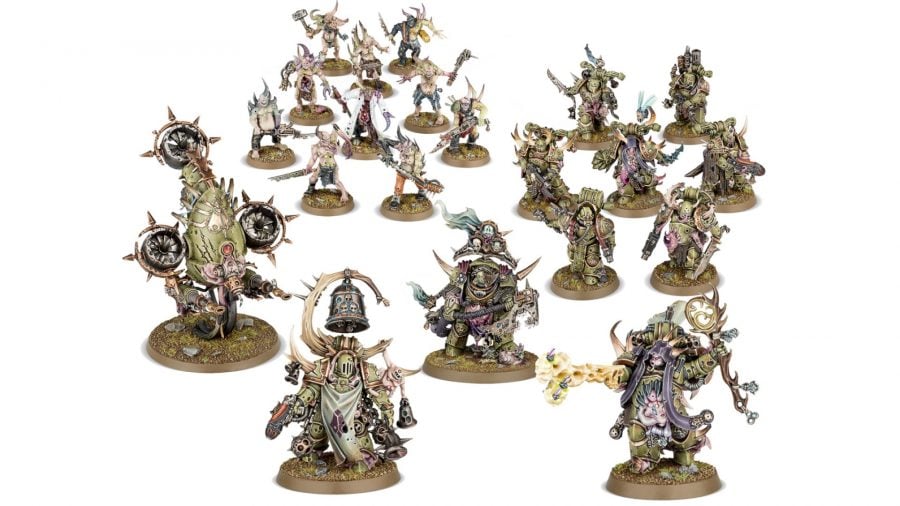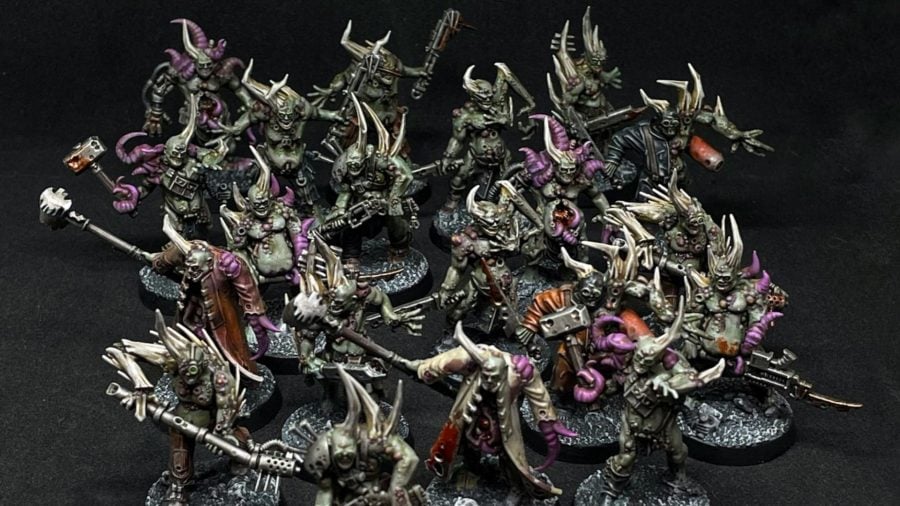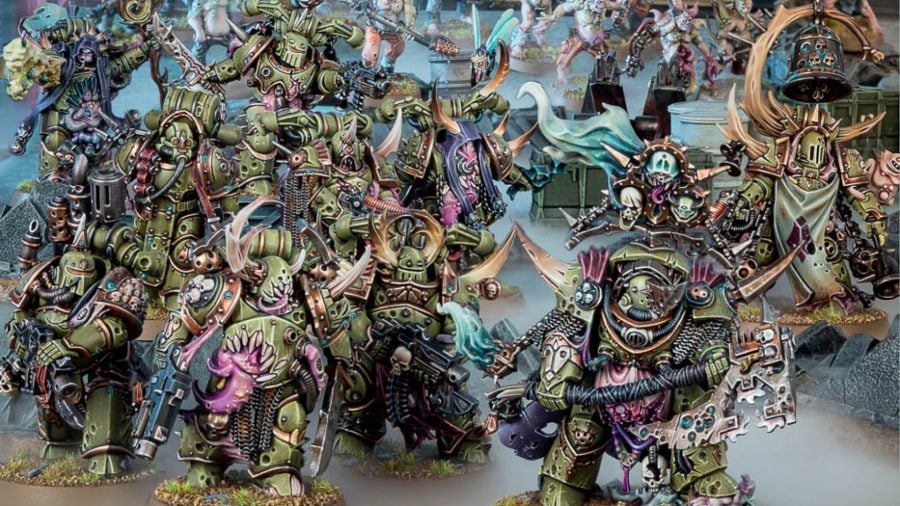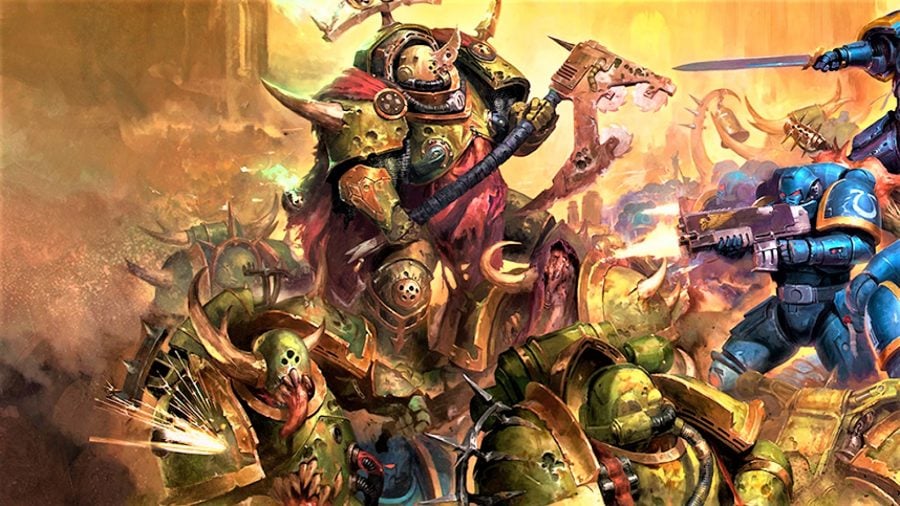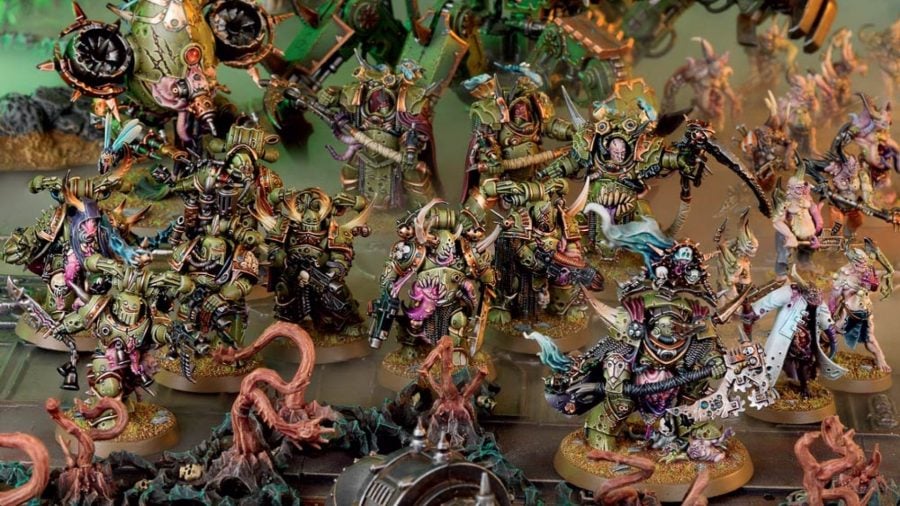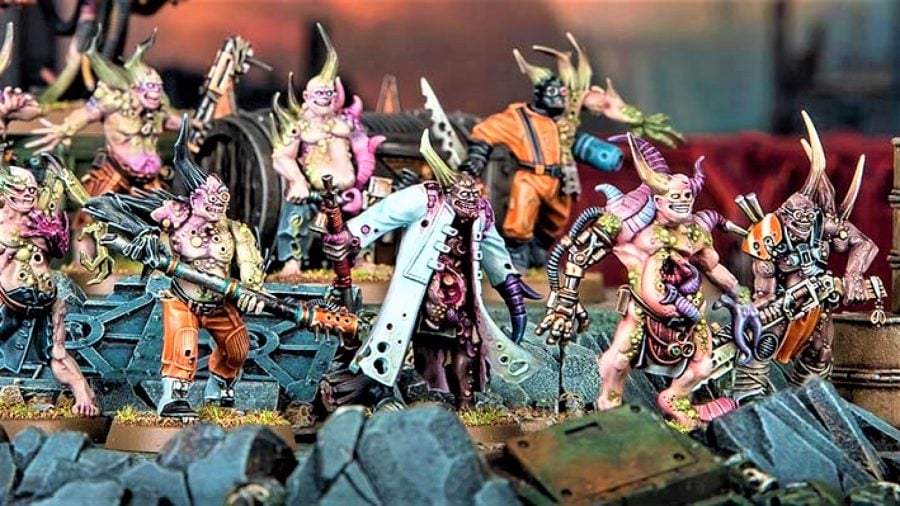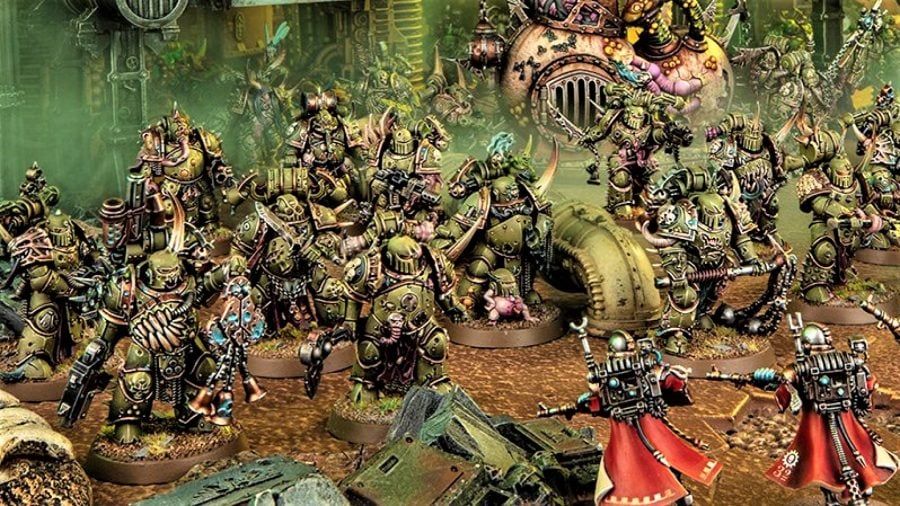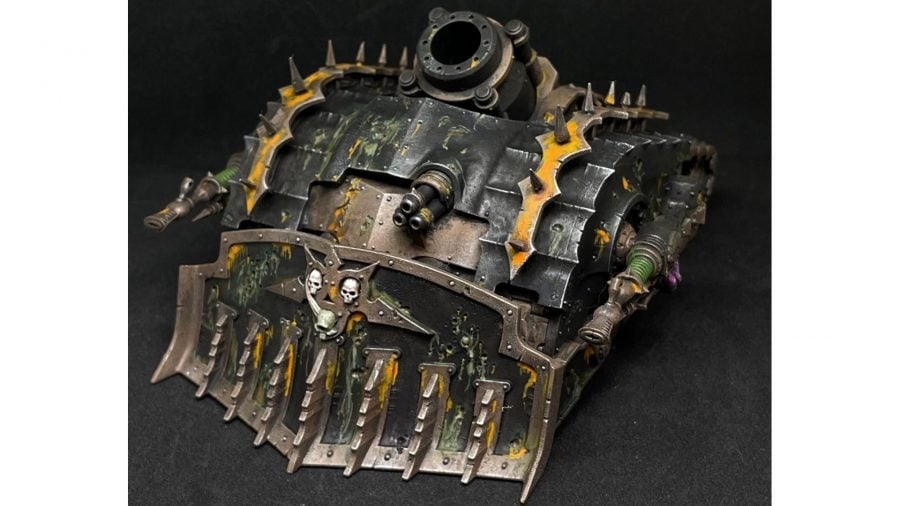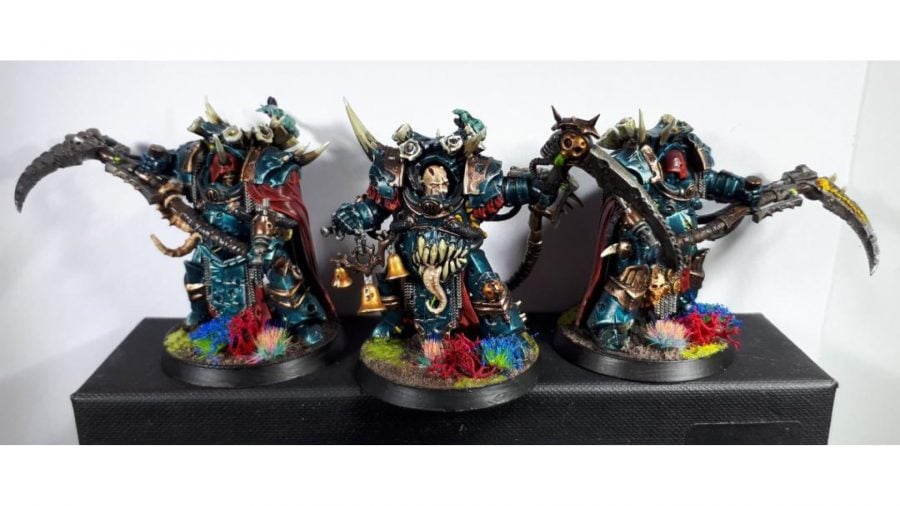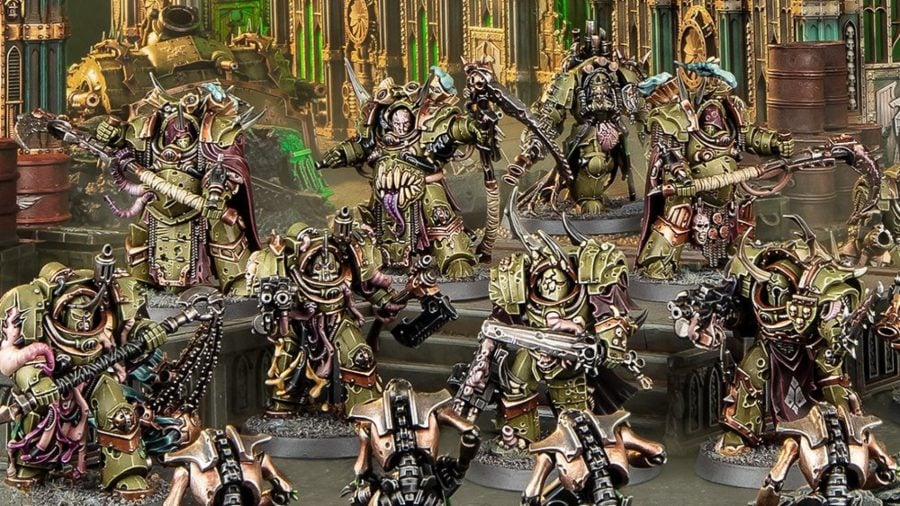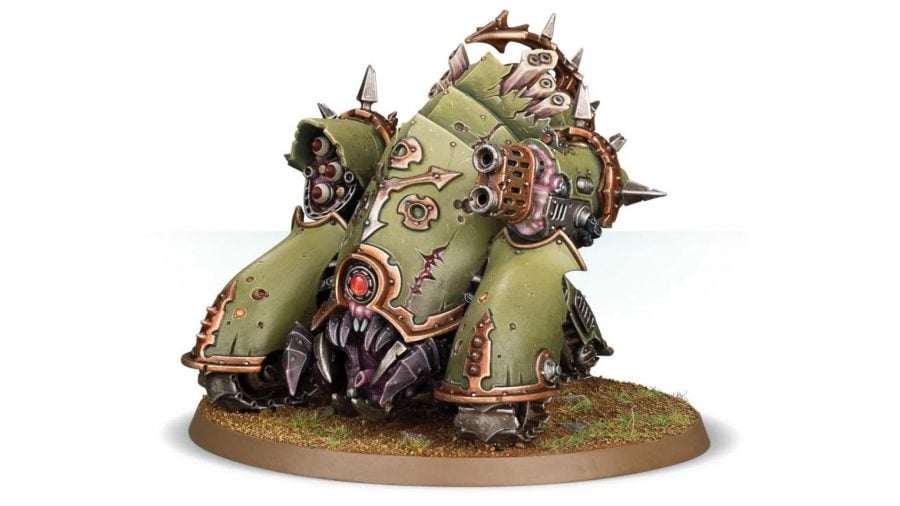Of all Warhammer 40k’s Chaos armies, the Death Guard are the very foulest. Cursed by an ancient pact with the plague god Nurgle, each one of them is impossibly afflicted by supernatural illness and insane mutation. Warhammer 40k’s Death Guard army features a diverse roster of revolting Chaos Space Marine warriors, making for a varied (if vomitous) array of tabletop possibilities. Read on for our guide to the Death Guard’s lore, tactics, and rules – and how you can dive into the filth yourself.
Warhammer 40k’s Death Guard are walking vectors of every infection imaginable, so diseased they should not be able to live, much less wage war in the name of their hideous patron – yet still they fight. In fact, paradoxically, their ailments lend them vigour, making them hardier than even the Primaris Space Marines. And, far from resenting their plague-bearing plight, they rejoice in the sickness, and revel in spreading their feculent patron’s gifts to an unwilling galaxy.
Shambling, once-human Poxwalkers crowd forwards ahead of the main force, their mouths twisted into rictus grins, their bodies deformed by peculiar mutations. Behind them, rumbling vehicles grind through the putrefying soil. Some of them are ancient Predator and Land Raider tanks, now pocked with corrosion and afflicted with fleshy growths, relics of a war they’ve waged for 10,000 years.
Others, such as the slug-like Plagueburst Crawlers and rabid, triple-tracked Myphitic Blighthaulers, are so-called ‘daemon engines’ – the souls of malevolent warp beings shackled into a physical machine.
And, among this cavalcade of madness, the Chaos Space Marines of the Death Guard march stolidly forwards, plague-ridden bodies impervious to the puny weaponry flung against them by terrified defenders.
The Death Guard are the rust-encrusted gauntlet of the plague god Nurgle. If you want an army that laughs in the face of enemy fire and spreads corruption as readily as it does death, look no further.
Here’s what you need to know about the Death Guard:
Death Guard lore
The Death Guard were the XIVth Legion Astartes, one of twenty forged by the Emperor to spearhead the Great Crusade that would claim the galaxy in the name of humankind.
The Death Guard have always been known for endurance
Recruiting from the toxic world Barbarus, the Death Guard prided themselves on their hardiness, their indomitability, and their resistance to pain. They fought in the foulest of warzones, prosecuting the most uncompromising and gruelling sieges through swamps poisoned by industrial waste, trenches filled with radioactive contaminants, or jungles alive with alien plagues. They often deployed deadly and proscribed weaponry from the Dark Age of Technology, including viral bombs, radiation missiles, and crawling phosphex.
As the Horus Heresy approached, however, curdled pride turned the legion away from the Imperial cause, and towards darker ends. Captain Calas Typhon seeded secretive lodges within the legion, creating a secret society that was more loyal to the legion than to the Imperium, while the Primarch Mortarion nursed his own old grudges against the Emperor. Mortarion was among the first to declare his fealty for Horus when the Warmaster dragged the Imperium into civil war.
By the end of that devastating conflict, the Death Guard had fallen into the service of a more terrible master indeed. Nurgle, Plaguefather, Grandfather of Decay, Chaos god of plagues and foetid rebirth, delighted in the Death Guard’s stoicism and endurance, and transformed them into his vessels of contagion. Now the Death Guard stalk the stars, superhuman monsters made even more impossibly resilient and hideously deadly by the interference of the warp.
Heretic Astartes: Read our guide to the Chaos Space Marines
In 10,000 years since the Heresy, the Death Guard have struck out from their bases within the Eye of Terror to spread Nurgle’s blessings across the Imperium. Mortarion, now a Daemon Primarch of Nurgle, fights his brother Roboute Guilliman across the worlds of Ultramar, turning paradise planets into heaving mires of sludge and decay. First Captain Typhon is now called Typhus, Herald of Nurgle, and he has set his sights on the Charadon sub-sector, determined to reveal the hubris of Forgeworld Metallica, whose Tech-Adepts believe their blessed machines are immune to Nurgle’s supernatural infections.
Mortarion
Every champion of the Death Guard is a monster beyond the worst nightmares of mortals, terrifying death bringers that have sickened star systems and turned worlds to rot. But two among them cast shadows that are particularly long, and as dark as a gangrenous wound: the legion’s haunted genefather Mortarion, and his scheming First Captain, now called Typhus.
Mortarion grew up on a planet coated with cloying, toxic mists
Mortarion was one of the twenty Primarchs created by the Emperor of Mankind in his secret laboratories deep beneath the Himalaysian mountains of Old Earth. Like all his brothers, he was cast into the warp as an infant by the machinations of Chaos, arriving upon the poisonous world of Barbarus – an inhospitable world of towering peaks and benighted valleys. The air was a toxic fug, growing ever deadlier, the closer one came to the summits of the mountains and the fortresses of the xenos warp-crafters who ruled the world. The Primarch, whose superhuman physiology allowed him to thrive despite the inimical climate, soon came to the notice of one of those xenos ‘masters’, who adopted Mortarion their son.
Eventually, after many years of psychological torment at the hands of his adoptive father, Mortarion realised he shared a common humanity with the slave subjects of the world, and came to lead a guerrilla uprising of the human serfs.
Ancient empires: Our guide to Warhammer 40k’s Necrons
His truest comrades, whom Mortarion named the Death Guard, were drilled in discipline and fortitude, and equipped with armour of his own design, to allow them to overcome the insurmountable toxins of the mountain peaks, and launch attacks directly on the tyrants’ fortresses.
Mortarion’s personal liberation of Barbarus was never completed, however. His final assault on the highest peak, controlled by his own foster-father, faltered, the virulent poisons too much even for his superhuman constitution.
Mortarion was rescued by the Emperor – and despises him for it
Mortarion might have died then, were it not for the intervention of the Master of Mankind. The Emperor’s fleets arrived on Barbarus, toppling the final alien stronghold, rescuing Mortarion, and – in his eyes – robbing him of both victory and vengeance. By the time he led his Death Guard in the Siege of Terra, Mortarion had been fully embraced by the Plague God Nurgle, and transformed into the vast, bug-winged, daemonic form he now takes.
A terrifying, towering entity as large as an Imperial Knight, he still wields the arms and armour with which he fought during the Great Crusade – the xenos pistol Lantern and the mighty scythe Silence, clad in the Barbaran Plate – though they have been imbued with terrifying warp-power, as befits his status among the most exalted Daemon Princes of Nurgle.
On the tabletop, Mortarion is a true centrepiece model, both in size and in-game impact. As the undisputed master of the Death Guard and Nurgle’s affections, he has an unmatched four Warlord traits. Wielding a scythe the size of a dreadnought, he has the melee capability you would expect, while Disgustingly Resilient, a 4+ invulnerable save from the Barbaran Plate, and a 5+ chance to ignore wounds from the Revoltingly Resilient Warlord trait, make him extremely durable.
He radiates sickness: the Warlord Trait Living Plague prevents enemies within 3” from benefiting from friendly aura abilities, while the Arch Contaminator Warlord trait grants rerolls to wound for plague weapons against enemies within 12”.
Psychic wanderers: Our guide to the Craftworlds Eldar
His own Contagion abilities (more on them shortly) always spread to enemies within 12” of him, and, as well as the normal Death Guard ability to reduce enemy Toughness by one, Mortarion can also pick any other plague ability he chooses. As if that weren’t enough, he’s a powerful Psyker.
Mortarion will be target number one for your opponent, and some armies on the competitive scene (particularly Adeptus Mechanicus) will be able to answer him handily. But, if he has the chance to get to grips with the foe, he will tear that heart from the enemy with a single, diseased claw.
Typhus
Typhus, the Traveller, Herald of Nurgle, Host of the Destroyer Hive, master of the dead who walk… Typhus has many names, each one earned through uncountable atrocities enacted in the name of the plague God.
Influenced by the Word Bearers, Typhon set up a warrior lodge among the Death Guard
The Barbaran youth Calas Typhon kept a secret: he was gifted with psychic abilities, not unlike those of the alien masters that ruled the planet Barbarus. When he completed the trials that saw him uplifted into the ranks of the Astartes, he quickly learnt that his close friend Mortarion despised any hint of witchcraft, associating such things with his despised adopted father. Typhon suppressed his powers, turning his focus instead to mastering the martial discipline and fortitude that were the pride of the legion.
Typhon quickly rose through the ranks, earning a reputation for prowess and endurance that saw him elevated to the position of First Captain. But, after serving in a campaign alongside the Word Bearers legion, who had already been subverted to the secretive worship of Chaos, Typhon learnt of a different path – and of different masters who might look upon his psychic gift more favourably. Typhon founded the Sevenfold Lodge within the legion, a secretive organisation that became the seed of rebellion.
As the Heresy ground on, Typhon was drawn deeper under the sway of Nurgle. Mortarion was determined to spearhead the Warmaster’s assault upon Terra, but Typhon convinced him that the fleet’s navigators were agents of the Emperor, executing them all. Typhon then offered to use his gifts to guide the Death Guard fleet through the warp. Reluctantly, Mortarion accepted.
The Death Guard were quickly marooned within the warp, afflicted by supernatural sicknesses beyond the ability of even the Death Guard to resist. Their bodies bloated, putrefied, mutated, corrupted, running with pus and ichor, rot and gangrene, yet somehow incapable of dying.
Metallica: Read our guide to 40k’s Adeptus Mechanicus
The Destroyer Plague and Nurgle’s Rot ravaged them, driving warriors insane and rotting the very souls of the Astartes. Eventually Mortarion, most stoic and indomitable of the Primarchs, succumbed to the only path he could see that would end his son’s suffering: he pledged them all, body and soul, to Nurgle.
Typhon was richly rewarded. The billions of boiling flies that infested the fleet swarmed into his body, hollowing him and filling him with the indescribable sickness of the Destroyer Plague. Now Typhon was Typhus, host of the Destroyer Hive, a walking vessel for Nurgle’s sickness.
Since the failure of the Heresy, Typhus has followed his own path. Mortarion’s stronghold within the Eye of Terror disgusts him as sentimental, for Mortarion has sculpted the Plague Planet in mimicry of lost Barbarus.
Mortarion mostly leaves Typhus to do his own thing
For his part, Mortarion is content to let his wayward son roam, spreading Nurgle’s gifts across an unwilling cosmos. Sometimes they make war together, when the cause will aid Nurgle’s plans – such as when Typhus supported Mortarion’s conflict in the Ultramar Segmentum. Often, though, Typhus strikes out alone, or else lends his forces to Abaddon the Despoiler, of the Black Legion; Typhus was instrumental in spreading plagues before the 13th Black Crusade – the war that destroyed Cadia and rent the Imperium in two by opening the Cicatrix Maledictum.
On the tabletop, Typhus is a powerful HQ choice, combining psychic might and the formidable melee prowess of his Master-Crafted Plague Scythe.
As Nurgle’s Herald, he can also be fielded in forces drawn from any Plague Company, so you won’t be restricted in how you build the rest of your force by bringing him to the table.
Typhus also developed many of the plagues of undeath, and has a special affinity with Poxwalkers, increasing the strength of their rigor mortis-tightened claws.
Death Guard tactics
Death Guard bring a profusion of short range killing power and are extremely durable.
Winning with them will mean bringing that power to bear efficiently to remove the threats that can negate their endurance, claiming objectives intelligently, and being careful with positioning to mitigate the superior manoeuvrability or long-range firepower of your enemies.
Slow and purposeful
Not every unit in the Death Guard is slow, but none of them are really fast. Myphitic Blighthaulers and Foetid Bloat Drones have a 10” move, which is about as good as it gets. Plague Marines have a plethora of powerful short range weaponry and deadly melee plague weapons, but they lack any means to Charge after Advancing, and rely on the humble Rhino or bullet-magnet Land Raider for transport.
Death Guard are slow – get used to it
This is core to the Death Guard’s identity, and you’ll have to embrace it. You don’t have the manoeuvrability to chase nimble enemies, so you need to work out ways to bring them to battle on your own terms, teleporting Terminators into position to restrict enemy lines of retreat, or projecting overwhelming force onto an objective. When you do bring it all to bear on the enemy, the results can be devastating.
Disgustingly resilient
As befits the scions of Grandfather Nurgle, the corpulent bodies of the Death Guard are incredibly hard to destroy. Their bog-standard Plague Marines have Toughness 5 and two wounds, as tough as an Ork and as die-hard as a Space Marine.
On top of that, most units in the Death Guard army (except for mundane vehicles, Cultists, and Poxwalkers) benefit from Disgustingly Resilient – which reduces the damage characteristic of all wounding attacks they suffer by one.
Throne watchers: Our guide to 40k’s Adeptus Custodes
Chaos Spawn don’t have this Disgustingly Resilient ability as standard, but they can be upgraded to gain it (and +1 Toughness) for just one or two CP using the Grandfatherly Influence stratagem, and it’s well worth it. Heavy bolters, autocannons, overcharged plasma guns, master-crafted power swords, even an unlucky roll on a las-cannon: Plague Marines can take them all in their stride.
The Death Guard’s notorious Blightlord Terminators are even harder to shift: with a 4+ invulnerable save, three wounds apiece, and Disgustingly Resilient, a Leman Russ can unload its battle cannon on them and they’ll walk through with barely a scratch.
Death Guard bring other defensive abilities to the field, too. The psychic power Miasma of Pestilence inflicts a -1 to hit penalty on enemies targeting a chosen unit. The stratagem Cloud of Flies is costly, but makes a unit completely untargetable by enemy shooting unless it is within 12” or the closest eligible target of the shooter.
Death Guard have to wade through barrages of enemy fire
The noisome smoke that bellows from Myphitic Blighthaulers means enemy melee attacks suffer -1 to hit them, while the Belching Fumes stratagem reduces the attacks characteristics of incoming ranged fire by 1 to a minimum of 1; though situational, this is incredibly potent against the twin cognis lascannons wielded by the Ironstrider Ballistarii of the Adeptus Mechanicus. Though they often have to wade through barrages of enemy fire, the Death Guard have the fortitude to survive it, and close to killing range with the enemy.
Contagions and Plague Weapons – get down with the sickness
As you would expect from the Plague God’s favoured servants, Mortarion’s sons are absolutely riven with disease.
Many Death Guard wield Plague Weapons, which augment their conventional offensive potential with deadly viruses, radioactive toxins, or other chemical reagents. Hits from plague weapons can reroll to-wound rolls of one, to represent their lethality. Several stratagems synergise with this toxic armoury in different ways. Sickly Corrosion infects an enemy that is hit with a plague weapon, allowing all other attacks against that unit to reroll to-wound rolls of one for the rest of the turn.
First Legion: Read our guide to Warhammer 40k’s Dark Angels
Plague Weapons carried by champions and heroes can be further upgraded with Deadly Pathogens. These grant the Plague Weapon +1 Strength and another useful buff, depending on which one you pick. I’m particularly fond of upgrading the Lord of Virulence’s Twin Plague Spewer with Virulent Fever, turning it into a 12-inch-range Heavy weapon, putting out 2d6 auto-hitting shots at Strength 5, AP-1, Damage 1, that inflict mortal wounds on to-wound rolls of 6.
Every Death Guard ‘Bubonic Astartes’ (i.e. yucky green Space Marine) model emanates a growing aura of contagion. This will always affect enemies within melee range, and spreads out gradually to become a 12” bubble by turn four. As standard, this ‘contagion’ is Nurgle’s Gift, which reduces the Toughness of enemies by 1. Reducing Space Marines from Toughness four down to three means that your Plague Marines’ Bubotic Axes will wound them on rolls of just 2+. You can even choose additional contagions as Warlord traits.
Death Guard melee combat
Death Guard pack a heavyweight punch at medium to close range. The Foul Blightspawn’s Plague Sprayer is especially noteworthy: it’s a hideously powerful flamethrower of daemonic pus, with D6 Strength 7, AP -2, Damage 2 attacks that automatically hit, and re-roll 1s to wound. Mortarion’s silent bodyguards, the Deathshroud Terminators, wield smaller versions called Plaguespurt gauntlets, alongside their vicious Manreaper scythes.
The Trench Fighters stratagem gives Plague Marines an extra melee attack
Many Death Guard stratagems reward you for closing with the enemy. Diseased Effluents allows a Death Guard character to inflict a mortal wound on themselves in the command phase, ripping open their own plague-filled bodies to douse their foes in up to 2d3 mortal wounds. Trench Fighters grants every Death Guard armed with a plague knife (i.e. all Plague Marines) an additional attack in melee. And the simple Putrid Detonation allows you to guarantee that a destroyed vehicle explodes, inflicting mortal wounds on the enemy – a perfect send-off for a Myphitic Blighthauler you’ve hurled into the heart of the enemy lines.
Since their first incarnation in The Lost and the Damned, the Death Guard have carried Blight Grenades – shrunken heads filled with the plague God’s foulest gifts. All Plague Marines in power armour wield them.
The Blightening stratagem turns three Blight Grenades into Pistol 6 weapons instead of Grenade d6, letting more than one model in a squad fire them, and causing all six shots to automatically hit if your marines pull the pin while engaged in melee.
Tangled up in blue: Our guide to Warhammer 40k Ultramarines
The Biologus Putrifier can make that even more horrifying by upgrading the grenades of marines within 6” to AP -1 and Damage 2.
To free up your elite infantry to close with the enemy, use cheap troops (like Poxwalkers and Cultists) and ranged vehicles (like Plagueburst Crawlers and Predators) which can sit on objectives and lend their firepower across the board.
How to start collecting Death Guard
The Death Guard Combat Patrol box contains a tide of 30 poxwalkers, seven plague marines, a Biologus Putrifier, and the dreaded Typhus. This is a solid start to any force: Typhus is a terrifying Warlord who combines psychic might, combat prowess, and a buff for Poxwalkers into a single, filthy package.
30 Poxwalkers could be the beginnings of a shambling horde
On the one hand, 30 Poxwalkers could be split into three units of 10, to cheaply fill out your Troop slots or hold backline objectives, tucked neatly into a larger Battalion that focuses on daemon engines and terminators; on the other, it’s a solid start to creating a bone-chilling horde of the shambling dead.
Plague Marines aren’t considered an optimal choice for tournament gaming at the time of writing, but that could change at the next points update, and they’re a solid choice for friendly games. The Biologus Putrifier is a support unit who makes Plague Marines’ grenades and melee weapons deadlier.
Now, there’s a little wrinkle in the Patrol box. Though it comes with enough Poxwalkers to field two units, you can’t field more Poxwalker units than core Bubonic Astartes infantry. But, as you’re limited to just three Troops slots in a Patrol detachment, you need to pick an Elites infantry unit to balance the scales. And that means Terminators!
Latest rules: Our guide to Warhammer 40k codex release dates
While Deathshroud are holy terrors in melee, your force already suffers from a lack of ranged weaponry – so you’re better off with Blightlord Terminators. These are excellent, bringing respectable melee capabilities, some ranged punch, and extremely durable bodies.
At the moment your force has a lot of durability, but very little tank-stopping power or ability to project force – aside from your teleporting units. You can go in a few directions to resolve this, depending on your long-term goal for the force.
If you fancy teleporting Plague Marines, try a Terminus Est Assault Force
If you’re addicted to infantry, you have the core of a Terminus Est Assault Force, an ‘Army of Renown’ specialist army type found in War Zone Charadon Act 1: The Book of Rust. These represent the terrifying shock assaults launched from the teleportarium aboard Typhus’ flagship, and trade away all vehicles in exchange for some neat relics and psychic powers, and, most importantly, the ability to deploy any Bubonic Astartes infantry unit by teleporter. You can bring your patrol up to 1,000 points with a Death Guard Daemon Prince with Wings, and the Easy to Build Plague Marines box (or three blind boxes of Space Marine Heroes 3).
If you want to build a more conventional Death Guard force, and play with all of their toys, swap out the Daemon Prince for the Plagueburst Crawler or Myphitic Blighthauler daemon engines. Both will add anti-tank firepower; the Crawler is slow, durable, and carries a huge plague mortar that can target units out of line of sight, while the Blighthauler is fast, comparatively fragile, and happiest when it follows up a salvo of missiles and melta-fire by charging into enemy lines.
As you can see, you don’t need to invest much beyond your Patrol box to field a starting Death Guard force.
If you want to follow The Traveller and his terrifying teleport troops, a second Patrol box is the cheapest way to create a zombie horde and add to your troops, and you’ll be able to eBay your second Typhus and Biologus Putrifier.
Laugh a minute: These are the best Warhammer 40k memes
If you’d rather build a legend for your own Vectorium, you just need to select a secondary HQ choice to make a legal battalion, and you’re free to follow your diseased heart’s desire.
With thanks to Ash Curtis for his noxious yellow Plague Marines, Helterskelter for his sinister dark jade Deathshroud and Alexander Lachwitz for his black metal Typhus, Plagueburst Crawler, and Poxwalkers.
Source: Wargamer




